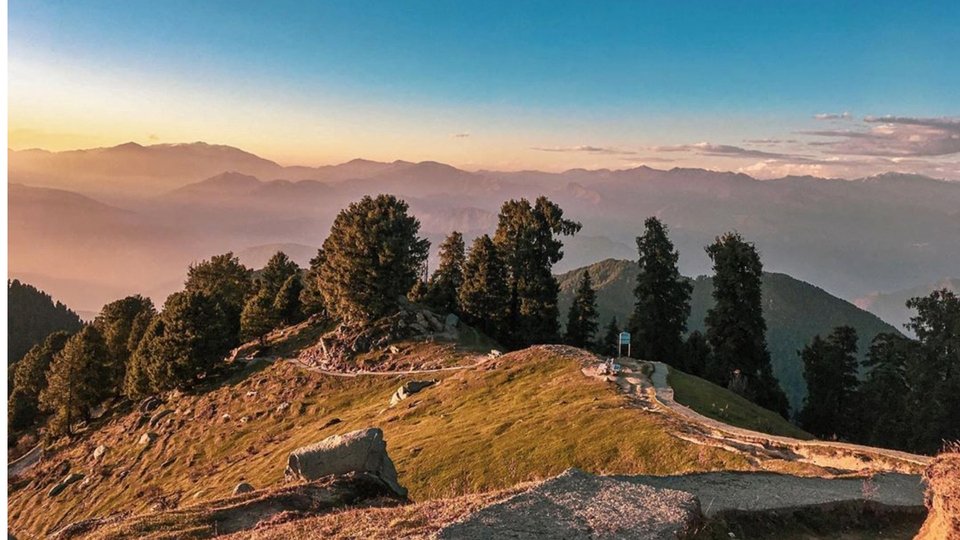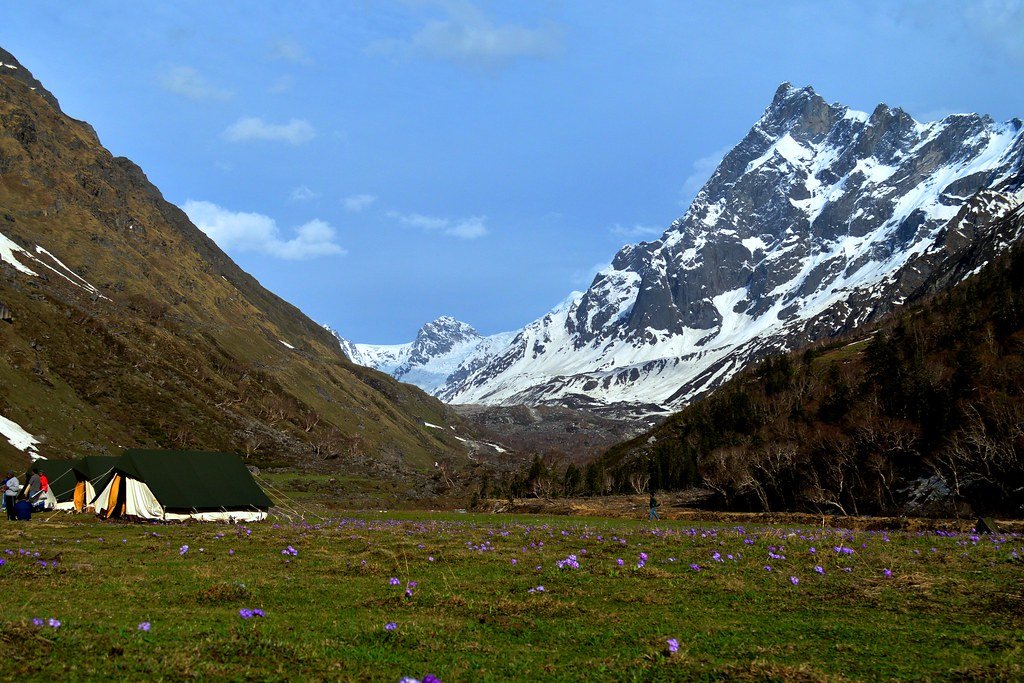Step Into Serenity In Chamba | 21 Places To Visit In Chamba | How to Reach
Chamba, situated in the Chamba district of Himachal Pradesh, India, is a picturesque town renowned for its rich history and stunning architecture. Established around 920 A.D., the town is located at an elevation of 996 meters on the banks of the Ravi River, where it meets the Sal River. The history of Chamba traces back to the 2nd century BC with the Kolian tribes, but it was formally governed by the Maru dynasty from around 500 AD. The town was later designated as the capital by Raja Sahil Varman, who acceded to the request of his daughter Champavati, after whom the town is named. Chamba is renowned for its plethora of temples and palaces, as well as its vibrant fairs such as the “Suhi Mata Mela” and the “Minjar Mela,” which showcase days of music and dance. The town is also famed for its arts and crafts, particularly the Pahari paintings and the exquisite Chamba Rumal, an embroidered handkerchief.

Best Places To Visit In Chamba:
The Chamba Palace showcases traditional hill architecture, while the Lakshmi Narayan Temple offers a peaceful spiritual retreat. Nature enthusiasts can explore Chamera Lake and the “Mini Switzerland of India,” Khajjiar. Rich in culture and tradition, Chamba hosts vibrant festivals like the Minjar Fair. Chamba is a perfect blend of natural beauty, spirituality, and cultural heritage, ideal for travelers seeking a peaceful yet enriching experience.
Here are some places to visit in Chamba:
1. Chamera Lake
Chamera Lake, situated in the Chamba District of Himachal Pradesh near Dalhousie, is a picturesque destination known for its tranquil beauty. It is a favored spot for boating and other water activities. The lake is actually a reservoir created by the Chamera Dam on the Ravi River, enveloped by verdant hills and lush greenery, offering a peaceful escape for tourists. Additionally, it serves as a vital component of the Chamera hydroelectric project, contributing significantly to the region’s electricity supply. Whether you seek adventure in water sports or seek solace in nature’s embrace, a visit to Chamera Lake is highly recommended.

2. Chaugan
Chaugan, located in Chamba, Himachal Pradesh, is a prominent and dynamic public space that serves as the town’s focal point. This expansive grassy field, measuring approximately 800 meters in length and 80 meters in width, is utilized for a variety of activities, including sports, picnics, and cultural events. Historically, it was leveled in 1890 and has since been a central hub for gatherings and recreational activities. Chaugan is particularly bustling during the annual Minjar Mela, a week-long festival celebrated in Chamba. It is also an excellent location for shopping for local handicrafts, including the renowned Chamba chappals (slippers) and Kangra paintings.

3. Bhuri Singh Museum
The Bhuri Singh Museum in Chamba, Himachal Pradesh, is a captivating repository of the region’s rich cultural heritage. Named after Raja Bhuri Singh, the museum houses a remarkable collection of artifacts, paintings, sculptures, and manuscripts that offer a glimpse into the history and traditions of Chamba. Established in 1908, the museum is renowned for its Pahari miniature paintings, which depict scenes from Hindu mythology, the life of Lord Rama, and the Radha-Krishna legend. The museum’s collection also includes traditional Chamba rumals (embroidered handkerchiefs), weapons, and musical instruments. With its diverse exhibits and historical significance, the Bhuri Singh Museum is a must-visit destination for history enthusiasts and art lovers alike.

Timings: Open from Tuesday to Sunday, 10 Am. to 5 Pm.
4. Laxmi Narayan Temple
The Laxmi Narayan Temple stands as a revered architectural wonder in Chamba, Himachal Pradesh. Constructed in the 10th century under the patronage of Raja Sahil Varman, it serves as the primary shrine in the town, encompassing a series of temples dedicated to Lord Vishnu and Lord Shiva. The temple complex is distinguished by its unique shikhara style, wooden chattries, and a shell roof designed to withstand snowfall. Additionally, it houses a metallic image of Garuda, the mount of Lord Vishnu. Revered for its historical significance and spiritual ambiance, the temple welcomes devotees during two distinct periods of the day.

Timings: Open from Morning: 6:00 AM to 12:00 PM.
Afternoon: 2:30 PM to 8:30 PM. Please note that the temple is closed on Mondays
5. Akhand Chandi Palace
The Akhand Chandi Palace, also known as the Chamba Palace, is a historic gem in Chamba, Himachal Pradesh. Erected in the mid-18th century under the patronage of Raja Umed Singh, it showcases a fascinating fusion of Mughal and British architectural styles. This regal edifice, characterized by its green roof and white-painted windows, commands attention as it overlooks significant sites such as the Chaughan and Lakshmi Narayan Temple. Originally serving as a royal abode, the palace has since been repurposed into a government college and district library, ensuring that its grandeur remains accessible for all visitors to appreciate.

6. Chamunda Devi Temple
The Chamunda Devi Temple in Chamba, Himachal Pradesh, is a revered sanctuary dedicated to Goddess Kali, also known as Chamunda Devi. Erected by Raja Umed Singh in 1762, it sits atop the Shah Madar Range, offering a breathtaking panoramic vista of Chamba. The temple, crafted entirely from wood and featuring gabled roofs, is accessible via a 3 km long concrete road. It is renowned for its cave-like architecture, symbolizing Lord Shiva, and enshrines idols guarded by Lord Hanuman and Lord Bhairav at its entrance. The temple’s intricate carvings and floral motifs contribute to its spiritual aura, rendering it a significant pilgrimage destination, particularly during Navratri.

Timings: Open daily from sunrise to sunset.
7. Kalatop Wildlife Sanctuary
Nestled in Himachal Pradesh’s Chamba district, the Kalatop Wildlife Sanctuary is a paradise for nature enthusiasts and trekkers. Encompassing an area of 30.69 square kilometers, it features dense deodar and fir forests that provide a home to various fauna, including the Himalayan black bear, ghoral, and barking deer. Renowned for its trekking routes, the sanctuary is located approximately 6 km from Dalhousie. It offers a serene escape into nature, allowing visitors to witness the region’s diverse biodiversity up close.

8. Manimahesh Lake
Manimahesh Lake, also known as Dal Lake, is a high-altitude lake nestled at 4,080 meters in the Pir Panjal Range of the Himalayas, situated in the Bharmour subdivision of Chamba district, Himachal Pradesh. This lake carries immense religious importance, akin to Lake Manasarovar in Tibet, and serves as the focal point for the Manimahesh Yatra, a revered pilgrimage trek. This trek takes place in August/September, during the eighth day of the new moon period in the Hindu calendar. Legend has it that the lake was created by Lord Shiva and is associated with various myths, including one where Shiva performed penance on its banks. The trek to the lake can be embarked upon via two routes, with Hadsar village being the more commonly traversed one. The tranquil waters of Manimahesh Lake, set against the backdrop of the majestic Himalayas, present a sight of profound beauty and spiritual significance.

9. Dainkund Peak
Dainkund Peak, fondly known as the ‘Singing Hill’, stands as the highest point in Dalhousie, Himachal Pradesh. Renowned for its captivating beauty, it offers panoramic vistas of the surrounding valleys. The peak is also home to the Pholani Devi Temple, enhancing its tranquil ambiance with a spiritual aura. A trek to Dainkund Peak is a delightful adventure for nature lovers and individuals seeking serenity amidst the mountains.

10. Khajjiar Lake
Khajjiar Lake, often hailed as the ‘Mini Switzerland of India’, is a breathtaking lake located in Khajjiar, in the Chamba district of Himachal Pradesh. Positioned at an elevation of approximately 1,920 meters above sea level, it lies nestled between Dalhousie and Chamba Town. The lake is ensconced within expansive verdant meadows and is surrounded by dense cedar forests. Its name is derived from Khajji Nag, the deity revered in the nearby temple. The tranquil ambiance and picturesque setting of Khajjiar Lake make it a favored destination for tourists seeking solace and natural beauty.

11. Sach Pass
Sach Pass, located in the Chamba District of Himachal Pradesh, India, is a high-altitude mountain pass nestled at 4,414 meters (14,482 ft) above sea level in the Pir Panjal range of the Himalayas. This pass serves as a vital link connecting the Chamba valley with the Pangi valleys. Renowned for its stunning and rugged natural beauty, Sach Pass is a favored destination for adventurous trekkers and motorists. Typically its accessibility depends on prevailing weather conditions. The road leading to Sach Pass is narrow and challenging, providing an exhilarating experience for those eager to explore one of the most remote and breathtaking regions in the Himalayas.

Timings: June or early July to mid-October,
12. Ganji Pahari
Ganji Pahari, located in Chamba, Himachal Pradesh, is a picturesque hill offering stunning views of the surrounding valleys and mountains. The name “Ganji Pahari” translates to “Bald Hill” due to its barren landscape devoid of vegetation. Despite its lack of greenery, Ganji Pahari attracts visitors for its panoramic vistas and peaceful ambiance. It’s a popular spot for picnics and photography, providing a serene escape from the hustle and bustle of city life.

13. Chamera Dam
The Chamera Dam is a key component of a hydroelectric project in Himachal Pradesh’s Chamba district, India. Situated near Dalhousie, the dam harnesses the waters of the Ravi River, creating the scenic Chamera Lake. Its construction was completed in 1994, comprising three stages known as Chamera-I, II, and III, which collectively contribute to the region’s power generation. The dam is distinctive for its lack of aquatic life, rendering the lake a prime location for water sports enthusiasts. The area surrounding the dam offers visitors a distinctive experience, characterized by fluctuating day and night temperatures.

14. Bhalei Mata Temple
The Bhalei Mata Temple, situated in Himachal Pradesh’s Chamba district, is a revered sanctuary dedicated to the Hindu Goddess Bhadra. Positioned on a 3,800 feet high spur in Bhalei, the temple lies approximately 35 km from the Salooni Tehsil headquarters and is accessible from both Chamba and Dalhousie. The temple is renowned for its two feet high black stone idol of the deity, which is believed to perspire during the Navratri festivals, symbolizing the fulfillment of devotees’ wishes. The temple’s history is intertwined with Raja Pratap Singh, who constructed it following divine instructions from the goddess herself. It has undergone several renovations over time, including one after the recovery of the stolen statue of Bhader Kali in 1973, which is now also believed to perspire since the event. Beyond being a place of worship, the Bhalei Mata Temple offers stunning views of the surrounding landscape.

Timings: Open from 05:30 AM to 08:00 PM.
15. Church of Scotland
The Church of Scotland, also recognized as St. Andrew’s Church, stands as a significant historical monument in Chamba, Himachal Pradesh. Constructed in 1903, it serves as a Protestant church, boasting Scottish architectural influences evident in its arched windows and intricate carvings. The church has retained much of its original structure, undergoing minimal alterations over the years, apart from the addition of a boundary wall. Positioned in the heart of Chamba’s main market, adjacent to the renowned Laxmi Narayan Temple, it is distinguished by its earth-colored stone facade and understated yet graceful design.

16. Thala Waterfall
Thala Waterfall, a captivating natural wonder near Bharmour in Himachal Pradesh’s Chamba district, is a perennial cascade that plunges into a pool at its foot, forming a picturesque sight. Located a mere 100 meters from Thala Bridge, the waterfall is easily reachable, offering visitors a chance to relish the tranquil ambiance and perhaps indulge in a peaceful picnic amidst nature. However, swimming in the pond is not advised due to the strong water pressure. Surrounded by lush greenery, Thala Waterfall is a favored destination for tourists and nature lovers alike.

17. Himachal Emporium, Rang Mahal
The Himachal Emporium, situated within the historic Rang Mahal in Chamba, serves as a focal point for local handicrafts. A haven for handcrafted enthusiasts, this emporium offers a delightful array of items, including exquisite shawls, handkerchiefs woven on wooden looms, and the renowned pickles of Chamba. The Rang Mahal itself is a splendid architectural masterpiece, blending British and Mughal styles, and has evolved into a prominent shopping destination for finely crafted goods. the emporium provides visitors with a unique opportunity to acquire authentic Himachali embroidery work on silky fabrics.

Timings: Open from 10:00 AM to 1:00 PM and 2:00 PM to 5:00 PM.
18. Hari Rai Temple
The Hari Rai Temple, an ancient and revered site in Chamba, Himachal Pradesh, is dedicated to Lord Vishnu. Renowned for its shikhara-style architecture, this temple houses a unique idol of Lord Vishnu with three faces—human, lion, and boar—crafted from eight different materials. Dating back to the 11th century, the temple was constructed by Salabahana and is located adjacent to the Chaugan Gate, the town’s official entrance. The main idol is adorned with exquisite traditional jewelry, and the temple’s saffron color coating makes it a standout spiritual and architectural landmark in Chamba.

Timings: open from sunrise to sunset for visitors.
19. Champavati Temple
The Champavati Temple, located in Chamba, Himachal Pradesh, is a historically and religiously significant site. Constructed by Raja Sahil Varman in memory of his daughter Champavati, this temple features stunning Shikhara-style architecture and intricate stone carvings reminiscent of Nepal’s architectural marvels. Dedicated shrines within the temple honor Vasuki Naga, Wazir, and Goddess Mahishasuramardini, an avatar of Goddess Durga. Legend has it that Champavati, the king’s spiritual daughter, disappeared, prompting the construction of the temple to avert disaster for the kingdom. Managed by the Archaeological Survey of India, this temple is a popular pilgrimage spot, especially during the Navratri festivals in March and September.

Timings: Open from sunrise to sunset.
20. Sui Mata Temple
The Sui Mata Temple in Chamba, Himachal Pradesh, is a revered site dedicated to Queen Sui, the wife of King Sahil Varman, symbolizing her selfless sacrifice. Legend has it that during a severe drought, the king was advised that only the sacrifice of a royal family member would bring water back to the region. Queen Sui volunteered to sacrifice herself in place of her son, and miraculously, water began to flow again after her death. Located in the Saho village of Chamba district, the temple is renowned for its beautiful paintings depicting Queen Sui’s life. It holds immense cultural significance, with an annual fair organized from March 15th to April 1st, where married women and girls visit to offer their respects to the queen. he temple complex comprises three parts: the main temple steps made by Rani Sarda, the wife of King Raja Jit Singh, leading to the Sarota stream.

Timings: Open from sunrise to sunset.
21. Bharmour
Bharmour, historically known as Brahmpura, served as the ancient capital of Chamba district in Himachal Pradesh, India. Nestled at an altitude of 2,100 meters in the picturesque Budhil valley, Bharmour lies approximately forty miles southeast of Chamba. Renowned for its breathtaking landscapes and ancient temples, some of which trace their origins back to the 10th century, Bharmour is often referred to as “Shiva Bhumi” or the Abode of Lord Shiva, reflecting its strong association with the deity. The region, also known as Gadderan, is inhabited by the nomadic shepherds known as Gaddis. It is enveloped by the Pir-Panjal and Dhauladhar mountain ranges, situated between the Ravi and Chenab valleys. The climate in Bharmour is generally mild during summer and can be quite cold in winter, with the primary rainy season occurring from June to September. with snow levels reaching up to 1.5 to 1.8 meters.

How To Reach Chamba
To reach Chamba, you can consider the following modes of transportation:
- By Road:
- Chamba is well-connected by road to major cities like Delhi, Chandigarh, and Pathankot. You can either drive or take a bus. The journey offers scenic views of the mountains and valleys.
- Book A Cab: you can book a cab from our website along with a customized itinerary or can hire just a cab for your next trip. So just do hurry. Call Us On:- +911223577273
- By Air:
- The nearest airport to Chamba is in Pathankot, about 120 kilometers away. From Pathankot, you can hire a taxi or take a bus to reach Chamba.
- By Train:
- The nearest major railway station is in Pathankot, which is well-connected to cities like Delhi, Amritsar, and Jammu. From Pathankot, you can take a taxi or bus to Chamba.
Here’s a table of trains running from Delhi to Pathankot along with their names, numbers, timings, and charges:
| Train Name | Train Number | Departure (Delhi) | Arrival (Pathankot) | Duration | Distance (km) |
|---|---|---|---|---|---|
| DURG UHP SPL | 08215 | 7:30 AM | 3:25 PM | 7h 55m | 477 |
| FESTIVAL AC SPL | 04401 | 11:50 PM | 7:23 AM | 7h 33m | 478 |
| JAT FESTIVL SPL | 02421 | 10:30 PM | 6:05 AM | 7h 35m | 476 |
| FESTIVAL SF SPL | 04131 | 12:05 AM | 9:15 AM | 9h 10m | 502 |
| NDLS JAT SPL | 02425 | 9:10 PM | 3:38 AM | 6h 28m | 478 |
| JBP SVDK SPECIAL | 01449 | 9:10 PM | 6:00 AM | 8h 50m | 493 |
| KOTA UHP SPECIAL | 09805 | 11:20 PM | 8:20 AM | 9h | 477 |
| KOTA SVDK SPL | 09803 | 11:30 PM | 9:15 AM | 9h 45m | 493 |
Chamba Weather & Temperature
Chamba, Himachal Pradesh, experiences a pleasant climate throughout the year. Summers (March to June) are mild with temperatures ranging from 15°C to 30°C, ideal for outdoor activities. Monsoons (July to September) bring moderate to heavy rainfall, making the region lush green but can lead to travel disruptions. Autumn (October to November) is cool and pleasant, with temperatures ranging from 10°C to 25°C. Winters (December to February) are cold, with temperatures dropping to 0°C, and the town experiencing snowfall, making it popular for winter sports. The best time to visit Chamba depends on preferences, with summer and autumn ideal for mild weather and winter for snow enthusiasts.
Nearby Places To Visit In Chamba
Here’s a table of major tourist attractions near Chamba, Himachal Pradesh, along with their approximate distance from Chamba:
| Tourist Attraction | Distance from Chamba |
|---|---|
| Mcleodganj | 125.6 km |
| Dalhousie | 46.7 km |
| Manali | 236 km |
| Dharamshala | 125.6 km |
| Kasol | 316 km |
| Keylong | 405 km |
| Amritsar | 232 km |
Please note that the distances for Kasol, Keylong, and Amritsar are not provided in the search results. For the most accurate and current information, it’s always a good idea to check a reliable map or navigation app before you travel.
Frequently Asked Questions:
What is Chamba HP famous for?
Chamba, Himachal Pradesh, is renowned for its ancient temples and Pahari paintings, set against the backdrop of the majestic Pir Panjal, Zanskar, and Dhauladhar mountain ranges. It also celebrates vibrant local festivals like the Minjar Mela and Suhi Mata Mela
What is the best time to visit Chamba?
The ideal time to visit Chamba is from March to June, when the weather is pleasant with moderate temperatures, perfect for sightseeing and outdoor activities. Autumn, from September to November, is also a great time with clear skies and comfortable climate.
What is the specialty of Chamba?
Chamba is celebrated for its exquisite Pahari paintings, a form of Indian miniature art, and its rich tradition of handicrafts and textiles, reflecting the cultural heritage of this Himalayan region.
Is there snowfall in Chamba?
Yes, Chamba experiences snowfall, especially in the higher reaches and during the winter months of December and January. However, snowfall in the town itself isn’t guaranteed every year.



